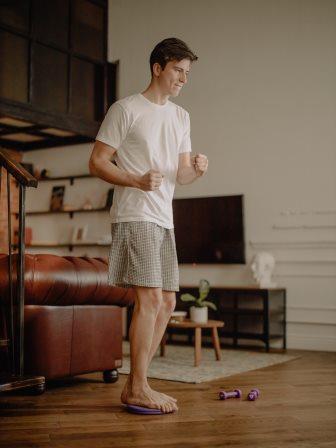Staying motivated with exercise
Mon 10 Aug 2020
Andrew Selvaggi shares what he has learned about staying motivated with exercise, with his inspiring story about turning his life around and his tips for managing under COVID-19 restrictions.
After frequent bruising and a cut on his upper lip which wouldn’t stop bleeding, Andrew was diagnosed with severe haemophilia A at the age of 15 months. No family history meant that Andrew’s haemophilia was the result of new or ‘spontaneous’ occurrence of the haemophilia genetic mutation.
Andrew developed inhibitors to his treatment – antibodies that stop the treatment from working well. The inhibitors further complicated his haemophilia: ‘
From age 0-11 there was not a treatment for me that worked properly.
I’d get a bleed and I’d pretty much have to sit there and ride it out until it went away, which without treatment can pretty much be weeks or months.’ Andrew estimates he spent around five years as a hospital inpatient by the time he was 11 years old.
When Andrew was 11 years old, his medical team found a treatment which worked with his inhibitors. Andrew describes this as a breakthrough for his childhood. ‘
I could do things like go to school more often, go on camps, do things I hadn’t really been able to do before.’
Up until this point in his life, Andrew had not been able to be physically active and as a result, Andrew had gained weight, becoming clinically obese. The result was tremendous stress on his body and joints and had a devastating effect on his self-esteem. ‘
To be honest I was in a pretty bad place mentally. Physically I was in an even worse place.’
Turning his life around
At 20 years of age, Andrew made the decision to turn his life around, equipped with the support and guidance of his Haemophilia Treatment Centre.
Andrew started exercising on an exercise bike and with his Treatment Centre, developed an individualised resistance and cardio training program coupled with a new treatment plan. Andrew admits it wasn’t easy, but he lost 30 kilograms of weight and his bleeds decreased from three bleeds a week to one bleed a month. His bleed recovery times were almost halved. If he experienced setbacks, he worked around them with the support of his Treatment Centre.
With a new understanding about the importance of health and wellbeing, Andrew became a qualified Personal Trainer. Several years ago he took a step back from full-time personal training. This was due to the strain on his knee joint, where he had bleeds previously, which resulted in a knee replacement. Andrew was philosophical about what he had learned from the experience.
‘I will always have haemophilia and still require treatment, but I know my limits. As I get older, I appreciate limits – knowing what your body is capable of and not pushing it too far. You need to listen to your body.’
Andrew devotes his life to helping others with bleeding disorders and their sport and fitness programs. He still maintains his health and fitness regime to prevent the pain and complications he experienced as a boy.
Exercising at home
During the COVID-19 pandemic, in isolation, Andrew wanted to keep up his exercise and but hit some roadblocks when indoor and outdoor gyms closed. And when he went to purchase home gym equipment, the shops had all sold out! But Andrew didn’t let that stop him and instead, became inventive with some items he found around the house.

Andrew’s tips for staying motivated can be used during quarantine or isolation and are also helpful if you’re feeling unwell and stuck at home.
- Routine is your friend
While you’re stuck at home (whether you’re working from home or recovering from an injury), the lines between work, family and personal can become blurry. Keeping your ‘normal’ hours can help you maintain some boundaries and routine. If you’re a morning person, wake up when you would on a ‘regular’ day and try to get some exercise in. If you’re a ‘night owl’, set aside some time in the evening instead. Give yourself an incentive and if you’ve got a favourite TV show, only watch that show when you’re doing a workout at home.
Don’t forget to consider your own physical limitations and safety when exercising at home. Always consult with your medical team and physiotherapist to know if a workout is safe for you and which exercises might need to be modified.
- Take advantage of your extra time
Not travelling to and from work or study will leave you with extra time up your sleeve. Use this extra time to your advantage. You could take a morning walk, do a workout in your lounge room or even stretch and work on your flexibility. Use this time to work on yourself and when life returns back to normal, you will come out mentally and physically ready.
- Mental health and physical activity
Did you know that being physically active can help improve your mood? Not only does exercising make your brain focus on the task at hand and give you a mental break, but it’s a good way to balance any stress at work or home. After your workout, not only will your body feel great, but exercise will release ‘happy chemicals’ and improve the way you feel.
- No equipment = no problem
All you need is a solid floor and your imagination. A number of items you might find around your house can be used as exercise props, such as chairs, stairs, benches and walls. Searching online for “HIIT” (High Intensity Interval Training), ‘core & balance’, yoga and Pilates videos are a great way to exercise – particularly if you look for ‘no equipment’ videos.
If you have any questions about starting a new exercise program, or exercising at home, speak to the physiotherapist at your Haemophilia Treatment Centre.
For more information about sport and exercise –